This week Beth (of V is for Vintage) and I got together and started pondering Regency short stays. I had done a bit of research into this when I made my first pair of Regency short stays, but I remember having read that people were questioning whether they were actually used as stays, or if they would be used sort of for undress, or morning wear.
I had previously made two sets of Regency long stays- my last set were back in 2008. My first set were a near failure- being too long in the torso and too restrictive in the bust. My second pair were little better- the fit was better, but still- I looked more like a teenager than a girl in her later 20s. Being on the small side in that department in general, I was much happier with the way the short stays worked with my figure.
I posted a question on “the stays question” on Facebook and had some varied responses. I have read varied responses elsewhere online as well. Some believe short stays better for the smaller busted. Some believe they’re better for the larger busted. Some think you must have the busk for proper support. Others think you do not need the busk. And still others think stays are of no necessity at all (perhaps that’s from the French directoire origins of the fashion, but I’m personally of the belief that it was just a few sensationalists rather than the population at large).
So I settled on it. Throw caution to the wind, I’m making mid-point stays. Not short stays, not long stays. I hate the way the long stays make me feel- way TOO restricted, and a pain to wear for my short-torso’d self. But now that I’m a little older, and I’m still on the smaller busted side of thing, I want a little more support for the upper tummy area. Especially for those of us that are smaller in that department, you need a little definition between bust and ribcage area, or else it all tends to blend and flatten. Yes, I know they had bust improvers, and that will probably be part of my plan eventually as well, but I think most people didn’t rely solely on those.
Thinking on my need and want, and seeing the vast, VAST variety of stay options out there during a time span of, say, 30 or so years, especially comparatively to the progression of stays and corsetry through most of it’s life span, I have settled upon it. After research, I can say, I think they just weren’t sure WHAT to do. It’s a hard thing to take women’s bodies, which are NOT naturally the ideal grecian form, and smash them into submission, except the bust, which should have been overemphasized. I’m convinced that what we see in paintings and fashion plates may have been the ideal of fashion, but since we don’t have photographs, of course, we’ve got to rely a little bit on the extremities of figure that are shown in caricatures. When we blend the ideal vs the extreme, I’m sure somewhere in the middle is where the average look and silhouette fell. And, you know, I don’t think that would be as hard to achieve.
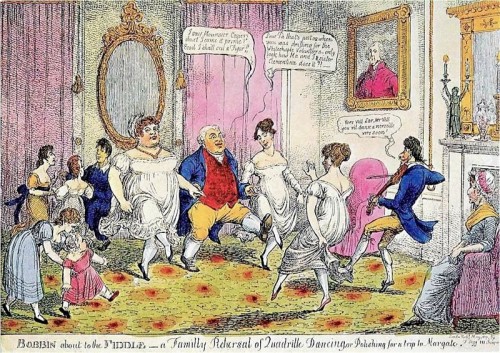
VS.
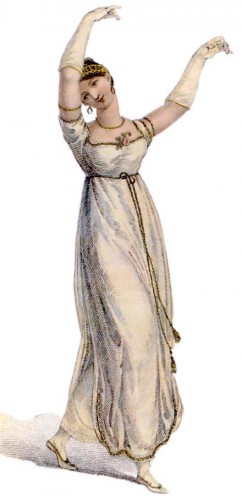
or
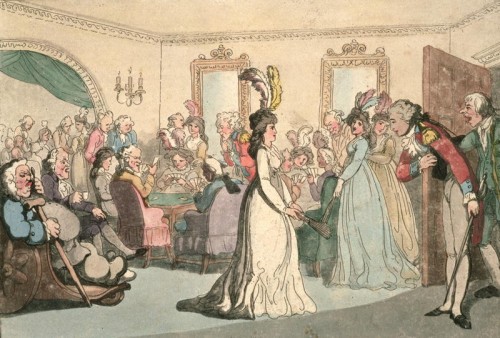
vs
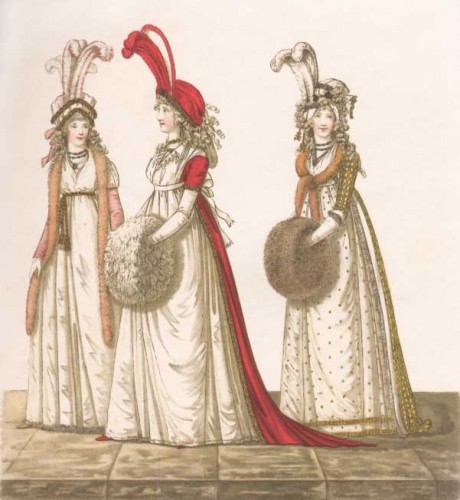
Or
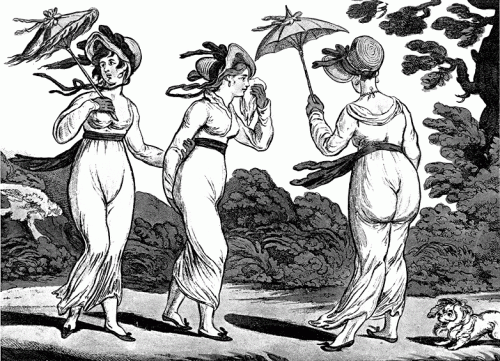
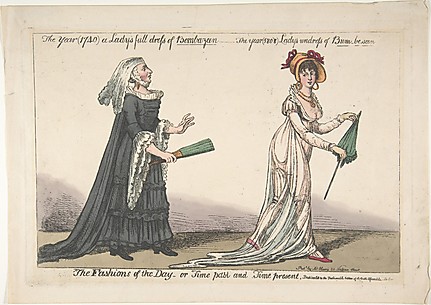
vs.
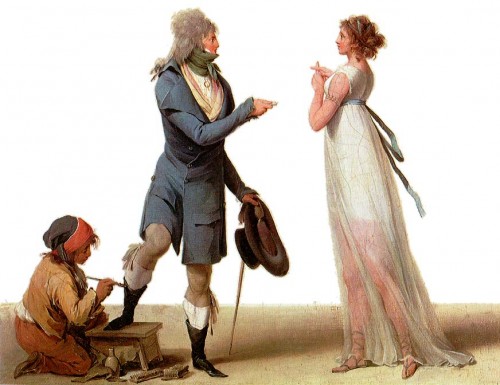
Surely, there has to be a midpoint. In fashion and reality, both had bosoms. Whether they’re false or real, is up to debate. But the difference in character or reality below the chest is where they get interesting. Nearly all the caricatures have a little something in the tummy area. The fashionable have very slender arms and features, similar to the ideal 1920’s look, but we all know that those were just what was in fashion, not always in reality. Compare the fashion images with real photographs of real people, and we see the difference. I’m convinced the same is true of our Regency counterparts. What makes it so difficult to achieve, except for the very fortunate to already possess that shape, is the columnar torso below the bust, but the extremely uplifted, almost to the height of armpits, apex (aka nipple point. Not to be crude, but that’s what it is). So unnatural, and yet so necessary for this period’s fashionable silhouette.
Since, for the terms of my reference, I’m looking at a wide scope of time- from 1798-1830ish, since the silhouette was really morphing and changing a lot during this time but retained a somewhat silhouette in the torso (I know, I know, different fullness, things went up and down, but the shape is somewhat similar), consider this from “The Duties of a Lady’s Maid: with Directions for Conduct, and Numberous Receipts for the Toilette” from1825
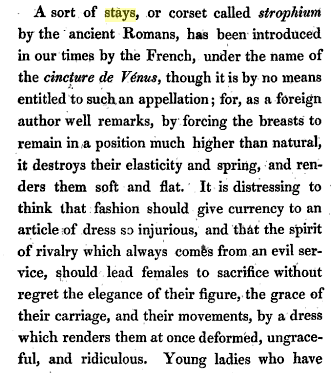

And a little later, regarding padding.
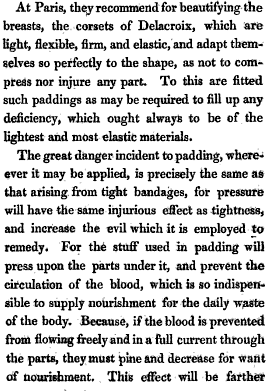
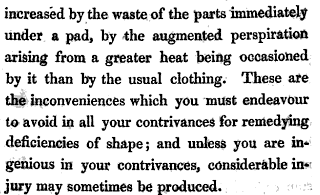
If you want to read more, you can find the whole book for free on Google Play.
But, not to help matters any more, on the question of long vs. short stays, I found the following in another book.
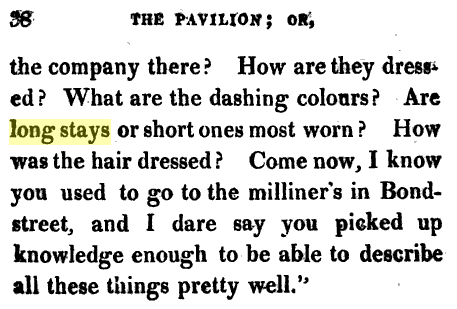
I’m sorry, I didn’t write down the book. But they didn’t bother answering their own questions anyways.
And, yet again, as an advertisement for a magazine:
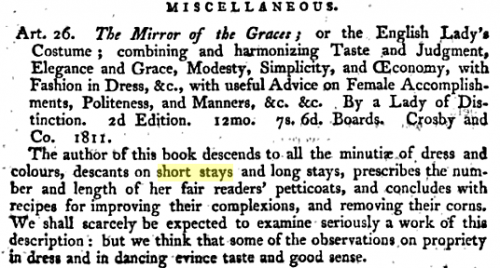
Apparently, I’m not the only one to question this, and after poking around on the internet, wouldn’t you know I found nearly EXACTLY what I envisioned in my head on the Kleidung Um 1800 blog? Go give it a read. She quotes exactly what I found in my copy of The Ladies Stratagem, so I don’t have to re-write it here, and her version of stays she made based on her research is superb.
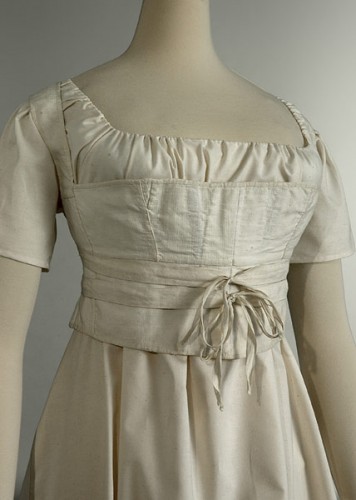
This extant set of stays (above) is what I pictured, but I thought of front vs back lacing, and I don’t want a crossover back or wrap around ties, except if doing so means you can lace yourself. I think the wrap versions were more for undress, or sleep stays. But I haven’t found much out about those yet in my research, so I may be mistaken.
But then comes the “to tab or not to tab” question…
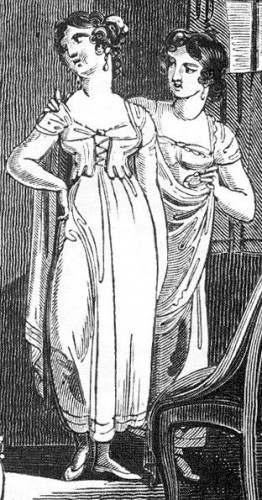
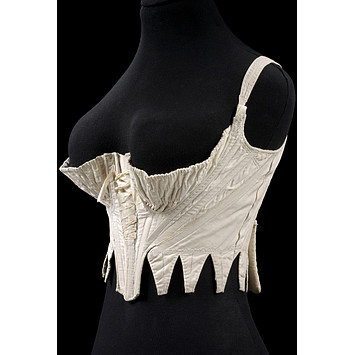
Sigh. There’s just too many options. I guess I need to decide if I’m going for earlier or later Regency. The drawing is later, 1820s. The one below is “transitional”, 1790s. Tabs seem somewhat old fashioned by the mid-late Regency. Plus, they’re more work. But they do look really nifty, and if I want to pad the back, it would lend very well to doing so.
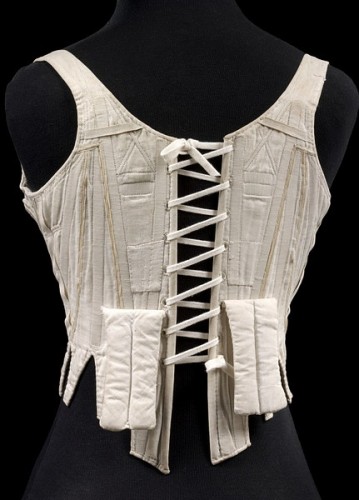
There’s just way too many options.
I created a Pinterest board, which has sources for most of the images above. I don’t own any of these images, just have been finding them online and been using them for research.
I had so much more I was going to post about, on my thoughts of extant stays, stays vs. corset vs. bodice, etc. But this post is already longer than I thought, so I’m signing off for now.

Corinne
January 31, 2014 at 4:17 pm (11 years ago)Oh my. I struggle with an under wire bra, I call them bra’s of death!! I have ample assets and would need major lacing, stays and support. On that note, good luck with this project. Sounds so interesting. I thoroughly enjoyed reading your research information.
Rozy
January 31, 2014 at 7:40 pm (11 years ago)I say wear what you want that is most comfortable. From my study of domestic history women wore a wide variety of things (not much different from today) except that it was only the very wealthy that kept up with with the changing fashions. Younger women were most interested in the latest styles. And because we don’t have a trunk full of everyone’s underclothing all neatly labeled with when it was made and when it was worn, we have to surmise that women wore what they, or a dressmaker, could make with available materials. You’ve done lots of research, choosing a mid-point make sense and is a reasonable answer to the dilemma. I’m sure you know that the only faux pas is wearing something that is later than the period you’re representing. Wearing something earlier is fine. You do gorgeous work and make such a wonderful contribution to the world of historic clothing. Thanks for all your sharing.
Heidilea
February 3, 2014 at 6:55 am (11 years ago)When doing my own stays research for the Regency/Federalist Era, I purchased the pattern made by Past Patterns, the short, “transitional” stay worn from the 1790s-1820s. Like you, I am in my early 30s and have a rather small bosom. When reading that the original on which she based her pattern was for a woman with a 44″ underbust, I started to wonder if these would even be appropriate for my figure. Then I read a review of Reconstructing History’s Pattern of the Kyoto Brassiere, and the woman complained that the “pattern was bad” because the strings cut into her back and made it lumpy, and the wrap around tape slid down in the front. She didn’t include a photo of the stays or herself, so I started to wonder again–maybe she wasn’t the right shape for that kind of stay and that’s why it didn’t fit her right?
I eventually stumbled on the Oregon Regency Society’s blog, with the stays/corset guide: http://oregonregency.blogspot.com/2010/06/overview-of-regency-stayscorsets.html, and of course, Kleindung 1800’s stays guide: http://kleidungum1800.blogspot.de/2013/05/short-stays-studies-schnurleib-studien.html.
Like you said, there are so many! I am going to try out the Kyoto Brassiere first, then if that doesn’t work, perhaps one of the other examples on Sabine’s site.